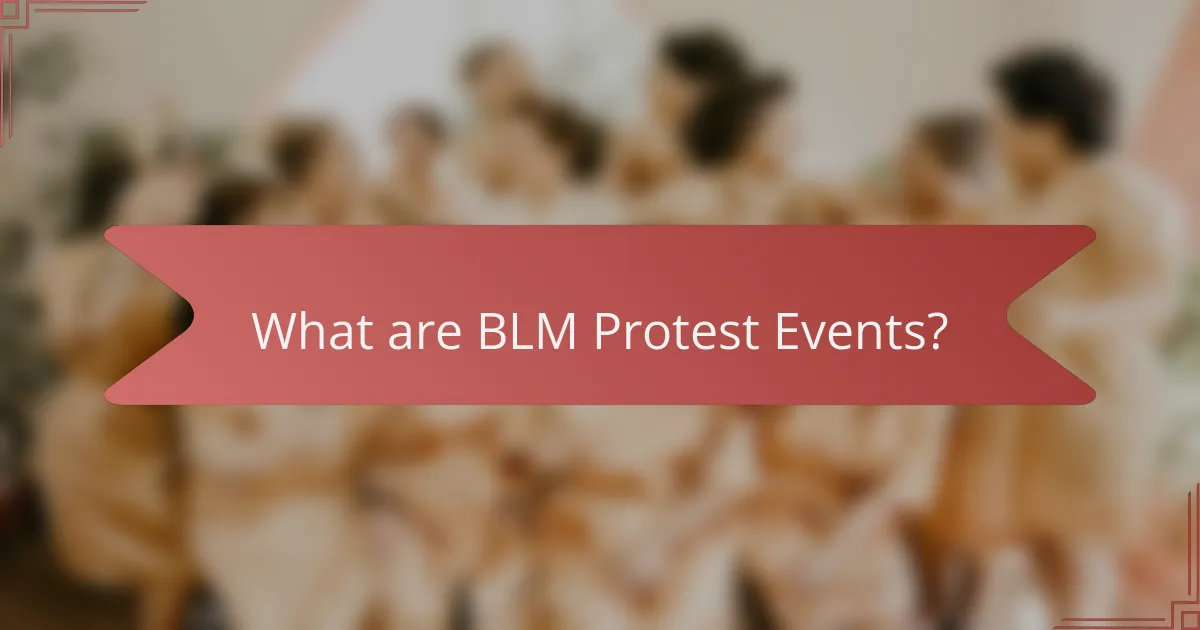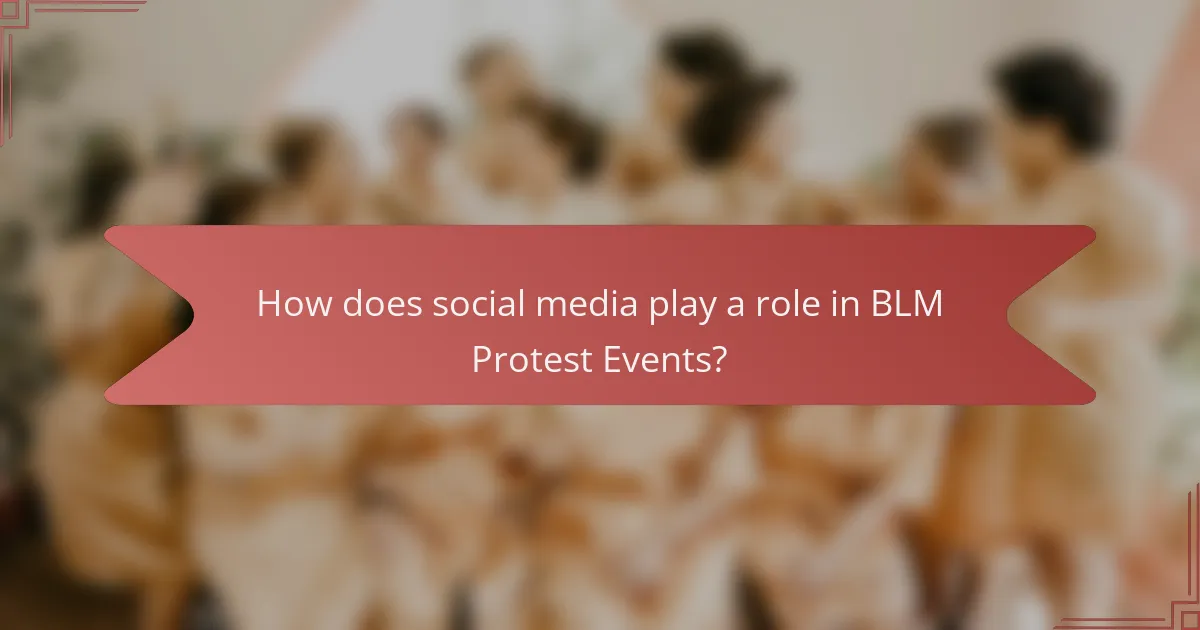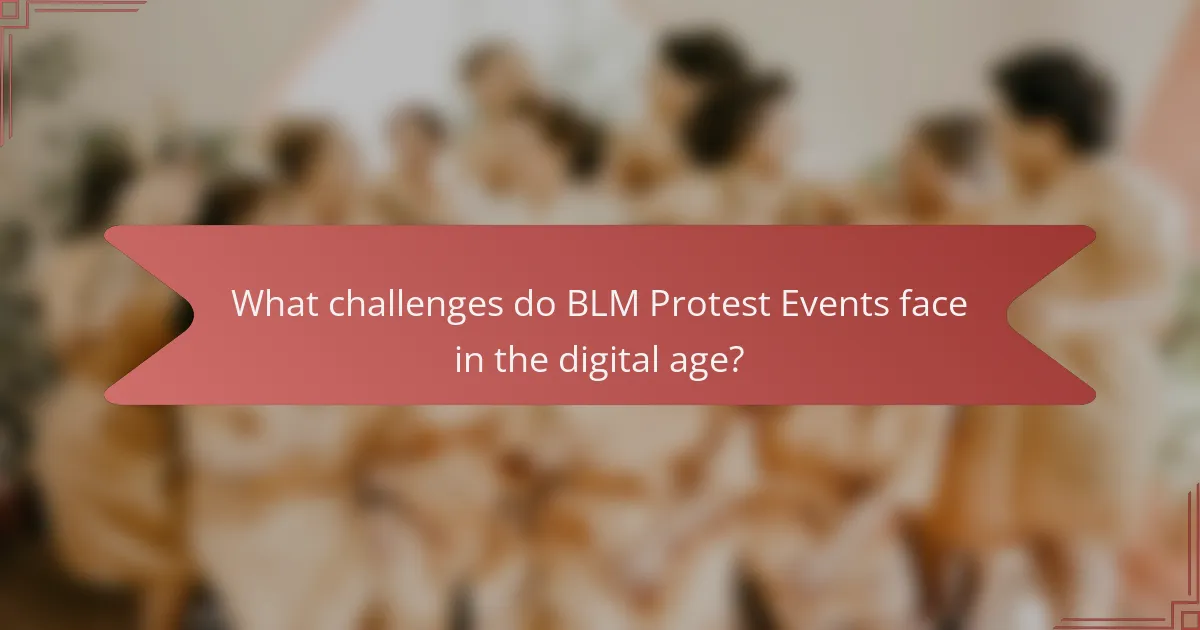
What are BLM Protest Events?
BLM protest events are organized gatherings advocating for racial justice and against police brutality. These events emerged prominently after the death of George Floyd in May 2020. They typically involve marches, rallies, and demonstrations in various cities. Participants express their demands for systemic change and equality. Social media plays a crucial role in mobilizing participants and spreading awareness. Platforms such as Twitter and Instagram are used to share information and coordinate actions. Studies show that social media has significantly increased participation in these events. The widespread use of hashtags, like #BlackLivesMatter, amplifies the movement’s message globally.
How do BLM Protest Events originate?
BLM protest events originate from grassroots movements responding to incidents of racial injustice. These events often begin with social media campaigns that raise awareness about specific cases of police violence. The hashtag #BlackLivesMatter was first used in 2013 after the acquittal of George Zimmerman in the shooting death of Trayvon Martin. This incident sparked widespread protests and discussions on systemic racism. Social media platforms provide a space for individuals to share their experiences and organize collective action. Mobilization occurs as users share information about events, locations, and ways to participate. The rapid dissemination of information can lead to large-scale protests in various cities. Research indicates that social media significantly enhances community engagement and mobilization efforts.
What historical events led to the rise of BLM Protest Events?
The rise of BLM protest events was significantly influenced by historical events such as the killing of Trayvon Martin in 2012. This incident sparked national outrage and highlighted issues of racial profiling and violence against Black individuals. The subsequent acquittal of George Zimmerman, the shooter, galvanized activists and led to the creation of the hashtag #BlackLivesMatter.
In 2014, the deaths of Michael Brown in Ferguson, Missouri, and Eric Garner in New York City further intensified the movement. Both cases involved police violence against unarmed Black men, resulting in widespread protests. The Ferguson unrest drew national media attention and showcased the role of social media in organizing and mobilizing protests.
The rise of BLM was also fueled by a growing awareness of systemic racism and police brutality, as highlighted by various incidents and reports. The 2015 release of the Department of Justice report on Ferguson revealed patterns of racial discrimination within the police force. This report, along with others, provided concrete evidence of the injustices faced by Black communities.
These historical events collectively laid the groundwork for the BLM movement, leading to increased visibility and participation in protest events across the United States and beyond.
Who are the key figures involved in organizing BLM Protest Events?
Key figures involved in organizing BLM protest events include Alicia Garza, Patrisse Cullors, and Opal Tometi. They co-founded the Black Lives Matter movement in 2013. Their activism has been instrumental in mobilizing communities and raising awareness. Other significant figures include local organizers and community leaders across various cities. These individuals often utilize social media to coordinate events and spread information. The movement’s success relies heavily on grassroots organizing and digital engagement.
What are the main objectives of BLM Protest Events?
The main objectives of BLM protest events are to advocate for racial justice and police reform. They aim to raise awareness about systemic racism and violence against Black individuals. Protest events seek to mobilize communities and encourage civic engagement. They also strive to hold public officials accountable for their actions. Additionally, BLM protests aim to foster solidarity among diverse groups. These objectives are rooted in the movement’s goal to create lasting change in society. Events often highlight specific cases of injustice to emphasize the need for reform. The protests serve as a platform for marginalized voices to be heard.
How do BLM Protest Events aim to address systemic racism?
BLM protest events aim to address systemic racism by raising awareness and demanding policy changes. These events highlight instances of racial injustice and police brutality. They create a platform for marginalized voices to be heard. Protests often attract media attention, amplifying their messages. Social media plays a crucial role in mobilizing participants and spreading information. Hashtags like #BlackLivesMatter unify efforts and broaden reach. Studies show that public protests can influence legislative change. For instance, the George Floyd protests led to discussions on police reform in various cities.
What social justice issues are highlighted during BLM Protest Events?
The social justice issues highlighted during BLM protest events include police brutality, systemic racism, and racial inequality. Police brutality is a central focus, emphasizing the violent treatment of Black individuals by law enforcement. Systemic racism refers to the ingrained policies and practices that perpetuate discrimination against Black communities. Racial inequality encompasses disparities in education, employment, and healthcare access faced by these communities. These issues are underscored by specific incidents, such as the deaths of George Floyd and Breonna Taylor, which sparked widespread protests. The movement seeks to raise awareness and demand accountability for these injustices, advocating for comprehensive reforms in policing and social systems.

How does social media play a role in BLM Protest Events?
Social media serves as a vital tool for organizing and promoting BLM protest events. It facilitates rapid communication among activists and supporters. Platforms like Twitter and Instagram allow users to share information about upcoming protests. This includes details such as time, location, and purpose. Social media also helps raise awareness about racial injustices, amplifying marginalized voices. The hashtag #BlackLivesMatter has gained global recognition, uniting individuals across various demographics. Studies have shown that social media engagement correlates with increased participation in protests. For instance, a 2020 Pew Research Center study indicated that 53% of Americans learned about BLM protests through social media. This demonstrates the platform’s effectiveness in mobilizing communities for social change.
What platforms are most commonly used for mobilization?
Social media platforms are the most commonly used for mobilization. Platforms like Facebook, Twitter, and Instagram facilitate rapid communication and organization. They allow users to share information, events, and calls to action. Facebook enables event creation and group discussions. Twitter’s hashtag system amplifies messages quickly. Instagram’s visual content attracts attention and engages younger audiences. Research shows that 79% of activists use social media for organizing efforts. This demonstrates the significant role these platforms play in mobilizing communities for social movements.
How do different social media platforms facilitate communication among activists?
Different social media platforms facilitate communication among activists by providing tools for rapid information sharing and community building. Platforms like Twitter allow for real-time updates and hashtag campaigns, which can quickly mobilize support. Facebook groups enable in-depth discussions and event planning among activists. Instagram offers a visual medium for storytelling and raising awareness through impactful imagery. TikTok engages younger audiences with creative content that spreads messages rapidly. Each platform serves unique functions, enhancing collaboration and outreach. For instance, during the BLM protests, hashtags like #BlackLivesMatter gained global traction on Twitter, uniting voices across regions.
What role do hashtags play in spreading awareness?
Hashtags play a crucial role in spreading awareness by categorizing content and enhancing visibility. They allow users to easily find and engage with specific topics. For instance, during the Black Lives Matter movement, hashtags like #BlackLivesMatter helped unify messages across various platforms. This increased the reach of posts significantly. According to a study by the Pew Research Center, posts with hashtags receive 12.6% more engagement than those without. This demonstrates their effectiveness in mobilizing support and raising awareness. Hashtags also facilitate the organization of events and discussions, creating a shared space for dialogue.
How does social media influence public perception of BLM Protest Events?
Social media significantly shapes public perception of BLM protest events. It serves as a primary platform for sharing information and mobilizing supporters. Real-time updates on protests spread rapidly, influencing how events are viewed. Visual content, such as videos and images, often evokes strong emotional responses. This can lead to increased empathy and support for the movement. Studies indicate that social media can amplify narratives around racial injustice. For instance, hashtags like #BlackLivesMatter create a unified message that resonates widely. Additionally, misinformation can also spread, complicating public understanding. Overall, social media acts as both a catalyst for support and a source of potential confusion regarding BLM protests.
What impact does social media coverage have on mainstream media narratives?
Social media coverage significantly influences mainstream media narratives. It shapes the topics that mainstream outlets prioritize. Social media platforms serve as real-time sources of information. They allow users to share eyewitness accounts and updates. This immediacy can lead to faster reporting in mainstream media. For example, during the BLM protests, social media highlighted key events and perspectives. This coverage often pushed mainstream media to cover these narratives more extensively. Studies show that social media can set the agenda for traditional news outlets. The result is a more diverse range of voices and stories being reported.
How do viral posts shape the conversation around BLM Protest Events?
Viral posts significantly influence the conversation around BLM protest events. They amplify awareness and mobilization efforts. Such posts often highlight key issues, events, and calls to action. They can rapidly spread information, reaching diverse audiences. This broad reach fosters community engagement and solidarity. Viral content often includes powerful imagery and testimonials. These elements evoke emotional responses and encourage participation. Studies show that social media engagement correlates with increased protest attendance. For instance, the 2020 protests saw a surge in participation linked to viral posts on platforms like Twitter and Instagram.

What challenges do BLM Protest Events face in the digital age?
BLM protest events face several challenges in the digital age. One major challenge is misinformation spread through social media. This can distort the message and objectives of the movement. Another issue is digital surveillance by authorities. Activists may be monitored online, which can lead to arrests or intimidation. Additionally, online platforms can limit reach through algorithm changes. This can reduce visibility for important posts and events. There is also the risk of digital burnout among activists. Constant online engagement can lead to fatigue and decreased participation. Finally, the digital divide affects access to information. Not everyone has equal access to technology, which can hinder mobilization efforts.
How do misinformation and disinformation affect BLM Protest Events?
Misinformation and disinformation significantly impact BLM protest events by shaping public perception and influencing participation. Misinformation can lead to confusion regarding protest details, such as locations and times. This confusion may result in lower turnout and fragmented movements. Disinformation can incite violence or provoke negative responses from law enforcement. For example, false claims about protestors’ intentions can escalate tensions. Research indicates that social media platforms often amplify these false narratives, affecting the overall atmosphere of protests. A study by the Pew Research Center found that 64% of Americans believe fabricated news has led to significant confusion about current events. Therefore, both misinformation and disinformation undermine the effectiveness and safety of BLM protest events.
What strategies are used to combat misinformation on social media?
Fact-checking is a primary strategy to combat misinformation on social media. Organizations and platforms employ fact-checkers to verify claims. These fact-checkers assess the accuracy of information shared online. They label false or misleading content to inform users. Additionally, social media platforms implement algorithms to reduce the visibility of false information. These algorithms prioritize credible sources over unreliable ones. User education is another effective strategy. Platforms provide resources to help users identify misinformation. Transparency in content moderation also builds trust. Social media companies share data about misinformation trends. This aids in understanding and addressing the issue effectively.
How does censorship on social media platforms impact BLM Protest Events?
Censorship on social media platforms significantly impacts BLM protest events by limiting the dissemination of information. This restriction can reduce public awareness and participation in protests. When posts about BLM events are suppressed, fewer people learn about the protests. Consequently, this can lead to lower turnout at events. A study by the Pew Research Center found that 69% of social media users obtain news about events through these platforms. If censorship occurs, this critical information source is compromised. Additionally, censorship can hinder organizers’ ability to communicate effectively. This can disrupt coordination and planning for protests. Overall, censorship can diminish the movement’s visibility and effectiveness.
What are the best practices for effective mobilization through social media?
Effective mobilization through social media requires clear messaging, targeted outreach, and community engagement. Clear messaging ensures that the purpose and goals of the mobilization are easily understood. Targeted outreach involves identifying and connecting with specific audiences who are likely to support the cause. Community engagement fosters a sense of belonging and encourages participation.
Using visuals, such as images and videos, can enhance the message’s impact. Engaging with followers through comments and shares builds stronger connections. Consistent updates keep the audience informed and motivated. Data shows that campaigns with high engagement rates can significantly increase participation in events.
For instance, during the Black Lives Matter protests, social media played a crucial role in organizing events and spreading awareness. Hashtags like #BlackLivesMatter helped unify the movement and amplify voices.
How can activists leverage social media tools for maximum impact?
Activists can leverage social media tools by creating engaging content that resonates with their audience. They should utilize platforms like Twitter, Instagram, and Facebook to share real-time updates and stories. This approach fosters community involvement and amplifies their message. Visual content, such as videos and infographics, increases shareability and reach. Collaborating with influencers can also enhance visibility and credibility. Data shows that campaigns with strong social media presence can increase participation in events by up to 50%. Additionally, using hashtags can unify conversations and make content discoverable. Engaging in timely discussions around relevant topics can keep the movement in public discourse.
What lessons can be learned from successful BLM Protest Events regarding social media use?
Successful BLM protest events demonstrate the importance of strategic social media use. Social media platforms effectively mobilized large crowds in real-time. They provided a space for sharing information quickly and widely. Hashtags like #BlackLivesMatter unified messages and increased visibility. Visual content, such as videos and images, engaged audiences and raised awareness. Real-time updates informed participants about event details and safety measures. Community engagement through social media fostered solidarity and support. Research shows that social media can amplify grassroots movements significantly, as seen in the 2020 protests.
BLM protest events are organized gatherings advocating for racial justice and against police brutality, prominently emerging after George Floyd’s death in May 2020. These events, often mobilized through social media platforms like Twitter and Instagram, aim to raise awareness about systemic racism and demand accountability for injustices faced by Black communities. The article explores the origins, key figures, objectives, and challenges of BLM protest events, emphasizing the critical role of social media in facilitating communication, mobilization, and public perception. It also addresses the impact of misinformation and censorship on these movements, providing insights into effective strategies for digital activism.